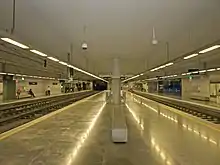Trindade station
Trindade is a station on the Porto Metro system in Porto, Portugal and a former passenger rail station on the Linha do Porto à Póvoa e Famalicão and Linha de Guimarães of the Comboios de Portugal rail company.
Trindade | |||||||||||||||||||||||||||||||||||
|---|---|---|---|---|---|---|---|---|---|---|---|---|---|---|---|---|---|---|---|---|---|---|---|---|---|---|---|---|---|---|---|---|---|---|---|
| Porto Metro station | |||||||||||||||||||||||||||||||||||
.JPG.webp) | |||||||||||||||||||||||||||||||||||
| General information | |||||||||||||||||||||||||||||||||||
| Location | Trindade square, Porto Portugal | ||||||||||||||||||||||||||||||||||
| Line(s) | |||||||||||||||||||||||||||||||||||
| Platforms | 4 side platforms | ||||||||||||||||||||||||||||||||||
| Tracks | 4 | ||||||||||||||||||||||||||||||||||
| Construction | |||||||||||||||||||||||||||||||||||
| Structure type | At Grade | ||||||||||||||||||||||||||||||||||
| Accessible | Yes | ||||||||||||||||||||||||||||||||||
| History | |||||||||||||||||||||||||||||||||||
| Opened | 7 December 2002 | ||||||||||||||||||||||||||||||||||
| Services | |||||||||||||||||||||||||||||||||||
| |||||||||||||||||||||||||||||||||||
Porto Metro | ||||||||||||||||||||||||||||||||||||||||||||||||||||||||||||||||||||||||||||||||||||||||||||||||||||||||||||||||||||||||||||||||||||||||||||||||||||||||||||||||||||||||||||||||||||||||||||||||||||||||||||||||||||||||||||||||||||||||||||||||||||||||||||||||||||||||||||||||||||||||||||||||||||||||||||||||||||||||||||||||||||||||||||||||||||||||||||||||||||||||||||||||||||||||||||||||||||||||||||||||||||||||||||||||||||
|---|---|---|---|---|---|---|---|---|---|---|---|---|---|---|---|---|---|---|---|---|---|---|---|---|---|---|---|---|---|---|---|---|---|---|---|---|---|---|---|---|---|---|---|---|---|---|---|---|---|---|---|---|---|---|---|---|---|---|---|---|---|---|---|---|---|---|---|---|---|---|---|---|---|---|---|---|---|---|---|---|---|---|---|---|---|---|---|---|---|---|---|---|---|---|---|---|---|---|---|---|---|---|---|---|---|---|---|---|---|---|---|---|---|---|---|---|---|---|---|---|---|---|---|---|---|---|---|---|---|---|---|---|---|---|---|---|---|---|---|---|---|---|---|---|---|---|---|---|---|---|---|---|---|---|---|---|---|---|---|---|---|---|---|---|---|---|---|---|---|---|---|---|---|---|---|---|---|---|---|---|---|---|---|---|---|---|---|---|---|---|---|---|---|---|---|---|---|---|---|---|---|---|---|---|---|---|---|---|---|---|---|---|---|---|---|---|---|---|---|---|---|---|---|---|---|---|---|---|---|---|---|---|---|---|---|---|---|---|---|---|---|---|---|---|---|---|---|---|---|---|---|---|---|---|---|---|---|---|---|---|---|---|---|---|---|---|---|---|---|---|---|---|---|---|---|---|---|---|---|---|---|---|---|---|---|---|---|---|---|---|---|---|---|---|---|---|---|---|---|---|---|---|---|---|---|---|---|---|---|---|---|---|---|---|---|---|---|---|---|---|---|---|---|---|---|---|---|---|---|---|---|---|---|---|---|---|---|---|---|---|---|---|---|---|---|---|---|---|---|---|---|---|---|---|---|---|---|---|---|---|---|---|---|---|---|---|---|---|---|---|---|---|---|---|---|---|---|---|---|---|---|---|---|---|---|---|---|---|---|---|---|---|---|---|---|---|---|---|---|---|---|---|---|---|---|---|---|---|---|---|---|---|---|---|---|---|---|---|---|---|
| ||||||||||||||||||||||||||||||||||||||||||||||||||||||||||||||||||||||||||||||||||||||||||||||||||||||||||||||||||||||||||||||||||||||||||||||||||||||||||||||||||||||||||||||||||||||||||||||||||||||||||||||||||||||||||||||||||||||||||||||||||||||||||||||||||||||||||||||||||||||||||||||||||||||||||||||||||||||||||||||||||||||||||||||||||||||||||||||||||||||||||||||||||||||||||||||||||||||||||||||||||||||||||||||||||||
| ||||||||||||||||||||||||||||||||||||||||||||||||||||||||||||||||||||||||||||||||||||||||||||||||||||||||||||||||||||||||||||||||||||||||||||||||||||||||||||||||||||||||||||||||||||||||||||||||||||||||||||||||||||||||||||||||||||||||||||||||||||||||||||||||||||||||||||||||||||||||||||||||||||||||||||||||||||||||||||||||||||||||||||||||||||||||||||||||||||||||||||||||||||||||||||||||||||||||||||||||||||||||||||||||||||
History
The modern metro station was built on the site of the former Trindade railway station, which was the central terminus for services to Porto from Trofa, Póvoa do Varzim and the Guimarães line. The original station was built in 1938 and demolished in 2001.
Trindade was also the main entry point for the tunnelling machine which excavated the tunnels for Line D in central Porto.
Services
It is the only station where Lines A, B, C, E and F (which run as one line within the metropolitan area) intersect with Line D. It is in the centre of Porto and is the busiest station in the system by passenger numbers. On Lines A, B, C, E, and F it is preceded by Bolhão and followed by Lapa, while on Line D it is preceded by Aliados and followed by Faria Guimarães.[3] The platforms for the A/B/C/E/F lines are at ground level under a sheltered roof, while the Line D trains are underground.
Passengers
In 2004, 14.8% of all ticket validations on the network were made at Trindade, down from 23.7% the previous year due to the opening of the Bolhão and Estádio do Dragão stations, but still comfortably the highest.
The station entrance and lower concourse are often used for fundraising and promotional events.
Building
Design
The station was designed by the renowned Portuguese architect and Pritzker Prize winner Eduardo Souto de Moura.
Layout

The platforms for the ABCEF line are at ground level under a sheltered roof. On this level, there are three platforms, with one being the old terminus for line Bx, which has since moved to Estádio do Dragão. To get to the far go-through platform for trains heading north, there is an underpass. The line D trains are underground, and the underpass must also be used to get to line D, whose platforms are underneath the underpass.
References
- Official Timetable 2012-2013
- UrbanRail.net
- Schwandl, Robert. "UrbanRail.Net > Europe > Porto > Porto Metro". Retrieved 12 February 2017.